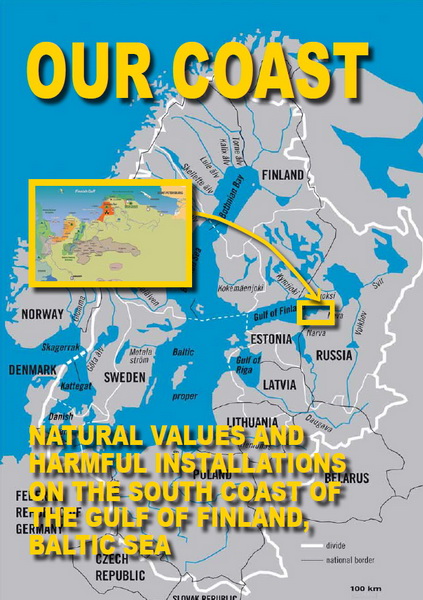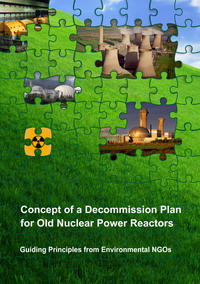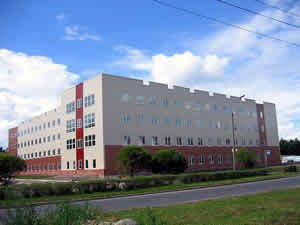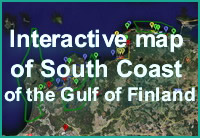
 |
The South Coast of the Gulf of Finland |
|---|---|
| Natural Values and Harmful Installations |
 |
Concept of a decommission plan for old nuclear power reactors |
|---|---|
| Guiding Principles from Environmental NGOs |
"Nuclear Taj Mahal" a simulator centre for Indian nuclear submariners will start operation in September 2005
Baltic News № 87
"Nuclear Taj Mahal" a simulator centre for Indian nuclear submariners will start operation in September 2005 on the South coast of the Gulf of Finland in t. Sosnovy Bor (80 km West of St. Petersburg).
For more than 40 years the models of developed nuclear submarines have been tested in the A.P.Alexandrov Research Institute of Technologies (NITI) in Sosnovy Bor. Additionally, a training center with a simulator for the nuclear submarine officers' exercise has been built here. In a month this formerly secret military facility will get the status of an international center for preparing submarine officers.
About 600 Indian officers together with their families will come to Sosnovy Bor for a long-term stay.A  simulator centre for Indian nuclear submariners will start operation in September 2005
simulator centre for Indian nuclear submariners will start operation in September 2005
After the December 2004 visit of President Vladimir Putin to India a new building was constructed in Sosnovy Bor, next to the Russian training center for nuclear submarine officers (see the photo). It was finished within a record-breaking period, and the locals call it "Taj Mahal". Flats in some recently-built houses will be rented by the families of Indian military men.
"This is a military facility of the federal level, so there will be no environmental examination and public hearings about its construction" - commented Natalia Malevannaya, chief environmental executive in Sosnovy Bor Administration, responding to the telephone enquiry of the GREEN WORLD.
60 years ago explosions of atomic bombs in Hiroshima and Nagasaki instantly exterminated hundreds of thousands people. The Treaty on non-proliferation of nuclear arms signed by the nuclear powers in 1968 determined the commitments of countries possessing atomic weapons, one of which was to maintain the non-proliferation practices.
There are all kinds of indicators proving the dramatic changes in the situation.
A leasing of two modern multi-purpose 3rd-generation nuclear submarines and, as mass media reported in the end of 2004, a possibility of their buying by India from Russia is likely to become a reality.
The submarines in question are probably the ones, which are being finished at the Amurskiy Ship-building Plant within Project 971 ("Schuka-B" (Pike-B) or "Akula" (Shark) in accordance with NATO classification). The current publications inform that finalization of two "Schukas", the readiness of which is estimated as 70-85 % and 40-60% will cost India not less than $400 million. And the annual leasing fee to Russia will be about $25million.
In the opinion of experts, the completion of both submarines, development of the harbor infrastructure and training of their crews may bring up to $2 billion to Russia.
This deal will stimulate India-Pakistan atomic controversy and nuclear arms race in the Indo-China region.
We should keep in mind that the Russian coast of the Baltic Sea, next to the 5-million St. Petersburg, is already saturated with nuclear-hazardous facilities: Leningrad NPP (LAES) with four RBMK -1000 reactors, several military research reactors for submarines in the NITI, temporary storages of high-level nuclear waste of LAES and NITI, which contain super-toxic radioactive materials enough for many dozens of "Chernobyls". This area also hosts "Radon" - regional surface storage facility of medium- and low-level waste collected in the Northwest of Russia, and also ECOMET-S - the largest in Europe plant for reprocessing radioactive contaminated metal.
All these facilities are sited at a distance from several tens to several hundreds of meters from the Baltic Sea shore. So there is a constant risk of contamination of the Baltic seawater, which washes the coasts of 9 European countries.
The establishment of the International Center for nuclear cooperation between the armed forces of Russia and India can make the nuclear- and radiologically-hazardous facilities on the seashore a target attracting the international terrorism.
The terrorist attack may have large-scale and long-term catastrophic consequences not only for Russia, but also for dozens of millions people living in all countries of the Baltic Region.
Oleg Bodrov and Tatiana Talalaeva.
The transfer of the published information is welcome.
When reprinting please refer to our periodical


